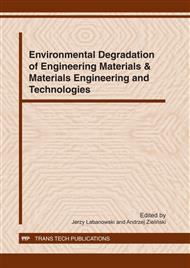p.1
p.9
p.17
p.25
p.31
p.37
p.43
p.49
FEM Analysis of Lower Premolar Root Canal Filling
Abstract:
Materials utilizing dentin adhesive technology were developed to provide more effective seal of a root canal. The combined use of new bondable root filling materials and self-adhesive sealers may increase the fracture resistance of filled canals. The null hypothesis of a positive influence on tooth biomechanics by a modern root canal filling material was tested in this study. In order to determine the strength characteristics of the analyzed endodontically treated human tooth the FEM (finite element method) was applied. Lower premolar was used to create a three dimensional model. Its canal was obturated using vertical compaction technique, gutta-percha and resin sealer, access opening was filled with composite resins. Strain analysis of the several elements of the tooth restoration does not allow attributing positive influence of contemporary obturating materials on mechanical properties of root canal dentin. Hypothetically, such an influence would have a filling material with comparable to dentin modulus of elasticity and flexural strength. It was also stated that loading the tooth with 250 N had an effect on increasing the tensions on the interface between filling material – sealer – canal wall. The stresses exceeded 4 MPa, reaching in extreme areas 10 MPa, what practically outweigh adhesion strength of modern root canal sealers. This phenomenon may provoke detachment of a filling from canal walls and therefore led to bacterial leakage. Results of this biomechanical analysis of the endodontically treated human premolar are valuable for a proper evaluation of mechanical properties of modern endodontic filling materials.
Info:
Periodical:
Pages:
17-24
Citation:
Online since:
December 2011
Authors:
Price:
Сopyright:
© 2012 Trans Tech Publications Ltd. All Rights Reserved
Share:
Citation:


